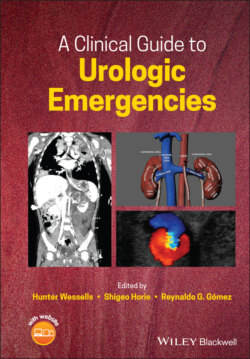Читать книгу A Clinical Guide to Urologic Emergencies - Группа авторов - Страница 26
Complications and Follow‐Up
ОглавлениеComplications after renal trauma are reported to be rare, occurring in about 5% of cases in modern series, although true rates of long‐term complications are difficult to define given the lack of long‐term follow‐up in the trauma population [25]. One retrospective series of grade IV and V blunt renal trauma evaluated the incidence of complications among patients who underwent immediate intervention versus those who were conservatively managed, subdividing the conservatively managed patients into successes and failures of conservative management [62]. Most were successfully managed conservatively. Of those who underwent successful conservative management (n = 142), 10.6% developed urinoma (n = 15) and 16.9% had hematuria (n = 24). Of those who failed conservative management (n = 12), 8.3% developed urinoma (n = 1) and 8.3% had persistent hematuria (n = 1).
Table 1.3 Long‐term follow‐up recommendations.
| AUA [34] | EAU [81, 82] | SIU/WHO [30] |
|---|---|---|
| Periodic monitoring of blood pressure up to a year after injury. Do not recommend routine DMSA (dimercaptosuccinic acid) or other functional nuclear scans. | Physical exam, urinalysis, “individualized radiological investigation,” serial blood pressure monitoring, and determination of renal function. Follow‐up should continue until healing is complete and lab findings have stabilized. Monitoring may need to be continued for years to evaluate for latent renovascular hypertension. | No specific recommendations, but consensus statement does cite a study that recommends that all grade IV/V injuries follow‐up with documentation of renal function by quantitative assessment |
Short‐term monitoring and follow‐up of trauma patients as previously specified is intended to detect complications and offer appropriate additional interventions. In terms of long‐term follow‐up, there is no consensus and most trauma series do not have the luxury of long‐term follow‐up, given the difficulty in following up the acutely injured population [80]. Follow‐up recommendations are outlined in Table 1.3.
